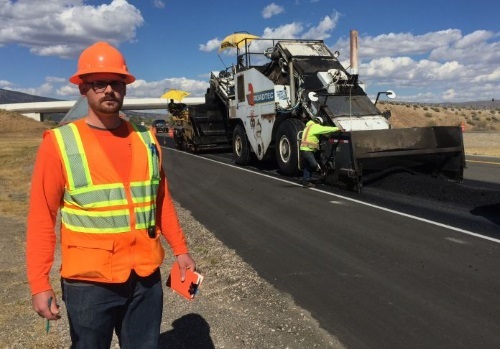The American Society of Civil Engineers recently released a 12-page report that indicates the “cumulative investment gap” between what the United States currently spends on surface transportation infrastructure versus what it needs to spend to decrease traffic congestion and maintain its assets in a state of good repair is approximately $5 trillion in 2019 dollars.
[Above photo by the Nevada DOT.]
The ASCE said in a statement that its report – entitled Failure to Act: The Implications of Investment Trends in our Surface Transportation Infrastructure – focuses on the impact of transportation deficiencies on U.S. economic performance. It also quantifies the “existing gap” between what the nation currently spends on bridges, roads, and transit systems versus what’s needed to get the systems into a “state of good repair.”

Subsequently, the report extends these trends out to 2039 to explore how underinvestment affects everything from personal household income to overall economic competitiveness.
If industry costs are passed onto consumers, ASCE estimated that the “cost per household” could be as high as $12,500 over 20 years, or $625 dollars per year.
Over time, the effects of transportation underinvestment continue to accrue, with losses to households and industries amounting to $677 billion between 2020 and 2029 period; expanding to $1.5 trillion between 2030 and 2039 decade. The United States is also projected to lose more than 540,000 jobs due to surface transportation inefficiencies – largely in the professional services, manufacturing, and health care sectors – by 2040.

During a virtual presentation of the report on September 23, K.N. Gunalan – ASCE’s 2020 president – noted that “the cost of continuing to underfund America’s surface transportation system” is producing a “mounting burden” for American households and businesses.
“Meanwhile, the COVID-19 pandemic has exacerbated an already difficult revenue situation, and without federal support, worsening condition trends are likely to accelerate,” he pointed out.
Kristina Swallow, director of the Nevada Department of Transportation, provided a state-level view of the transportation underinvestment issue during the presentation.

“Nevada’s ability to keep up with the demands of road preservation and new construction will increasingly be a challenge unless action is taken now to increase revenue and provide for the long-term sustainability of the Highway [Trust] Fund,” she explained. “The costs of inaction will inevitably be passed down to the businesses, consumers, and visitors that make up the lifeblood of our economy.”
Meanwhile, where the nation’s transit systems are concerned, ASCE’s report estimates there is a current backlog of $176 billion for transit investments, considering the vehicles, facilities, and track that are already past their useful lives.

That amount is expected to grow to nearly $500 billion through 2039 as existing assets age and if transit capital investment is maintained at the current real level of funding.
ASCE added that its analysis relies on baseline data that predates the COVID-19 pandemic. Data sets and economic models generally lag one to three years behind the present to allow for data collection, validation, and publication – thus the economic modeling in its underinvestment report does not yet account for COVID-19 impacts.
Also unknown is the extent and permanence of pandemic-related changes to commuting trends and travel behavior, goods movement, and the long-term impacts to user-based transportation revenue streams.



